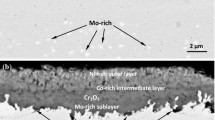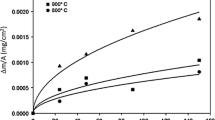Abstract
The corrosion behavior of several nickel and cobaltbase superalloys was examined in accelerated oxidation tests at temperatures between 800 and 1300 °F (430 and 700 °C) in O2 + 0.15 pct SO2 atmospheres and in the presence of corrosive deposits. The compositions of the deposits were calculated from thermodynamic considerations to represent the combustion products of several typical types of fuels. Penetration measurements on metallographic cross sections showed that at temperatures above 1050 °F (570 °C) the rate of corrosion increased rapidly. Metallographic inspection revealed thick, porous, nonprotective oxide scales with extensive cracks, but no internal Sulfides or chromium depleted zones. The extent of corrosion was dependent on the composition of the deposit; those containing Na, V, and Pb appeared to be about equally aggressive to most of the alloys, while the Kbearing deposit was most aggressive and the deposit containing Ca and Mg was least aggressive.
Similar content being viewed by others
References
S. Gordon and B. J. McBride: “Computer Program for Calculation of Complex Chemical Equilibrium Compositions”, NASA SP-273, 1971.
E. M. Levin,et al: “Phase Diagram for Ceramists”, Am. Ceram. Soc., Figs. 2914-5, 1969.
M. J. Zetlmeisl,et al: “High Temperature Corrosion in Gas Turbines and Steam Boilers by Fuel Impurities”, Trans. ASME,J. Eng. Power, 74-WA/CD-4, 1974.
Author information
Authors and Affiliations
Rights and permissions
About this article
Cite this article
Saegusa, F., Shores, D.A. Corrosion resistance of superalloys in the temperature range 800–1300 °F (430–700 °C). JMES 4, 16–27 (1982). https://doi.org/10.1007/BF02833378
Issue Date:
DOI: https://doi.org/10.1007/BF02833378




